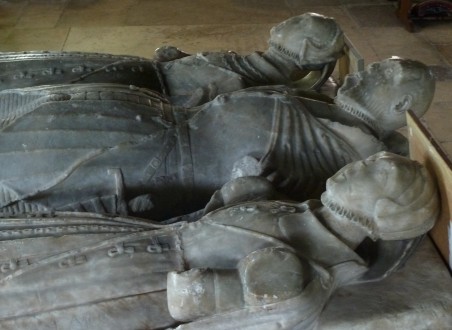Monumental Quirks – Healaugh
Effie Law | September 13, 2012
This is going to be the first in a series of posts looking at my favourite hidden gems and quirks from my research. I’d like to start by highlighting:
St John the Baptist Church, Healaugh, nr Tadcaster
Definitely with an emphasis on hidden, this Norman church is located in the tiny village of Healaugh in West Yorkshire. It is the final resting place for Thomas, Lord Wharton (d. 1568) whose funeral was analysed by Mervyn James in ‘Two Tudor Funerals’, in M. James, Society, Politics and Culture: Studies in Early Modern England (CUP, 1988). Information about the tomb which commemorates Lord Wharton and his two wives is scant. Pevsner, my usual go-to-guide for tombs, merely says:
“…Recumbant effigies. Tomb-chest with shields surrounded by circular bands with inscriptions. The panels are separated by balusters.”
Even the church itself provides more information about the Wharton Chapel at Kirkby Stephen where a second tomb to Lord Wharton was erected near to the grammar school that he had founded.
This fails to do justice to what is a sadly worn but nonetheless beautifully carved alabaster tomb with a number of quirks that brought a several questions to mind.
1) Inscriptions. This particular tomb has four different Latin inscriptions! One is a band of text running around the top of the tomb, sadly much destroyed making it hard to decipher. One is a rectangular block on inscription at the foot of the tomb. The final two have been carved into the base of the tomb and appear to the actual date of death for Thomas Wharton and one of his wives – these are not as decoratively carved as the other two but still look more professional than simple graffiti.
So, why are there so many inscriptions? When were they carved? And were they all carved at the same time?
2) Dress. If you look closely of the effigies of the wives, it is clear that while the skirts of their dresses have slight variations (think of a spot the difference puzzle) from the waist down they are remarkably similar.
Was this a cost saving method? Would we find the same skirts used on other female effigies carved by the same hand?
3) Graffiti. A lot of early modern tombs have been graffitied in subsequent generations and this is something that has been of interest to several researchers on this project. However, this particular tomb has a small cross carved into the forehead of one of the wives, which is not something I have seen before.
Is this something that is seen on other effigies from the same area/period?
If anyone has any thoughts about the above or similar examples, I would love to hear them!


